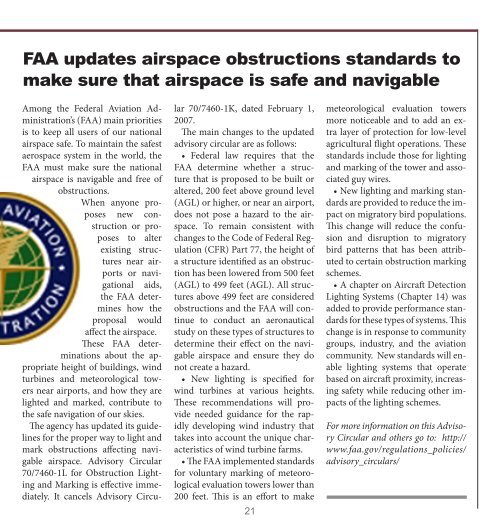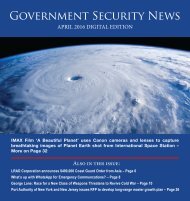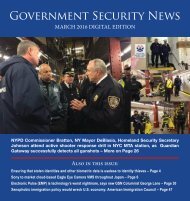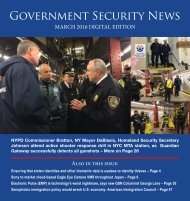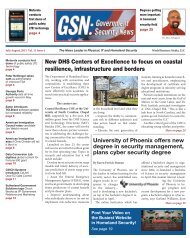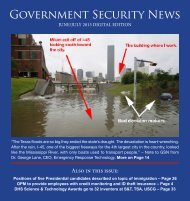GSN Dec 2015/Jan 2016 Digital Edition
You also want an ePaper? Increase the reach of your titles
YUMPU automatically turns print PDFs into web optimized ePapers that Google loves.
FAA updates airspace obstructions standards to<br />
make sure that airspace is safe and navigable<br />
Among the Federal Aviation Administration’s<br />
(FAA) main priorities<br />
is to keep all users of our national<br />
airspace safe. To maintain the safest<br />
aerospace system in the world, the<br />
FAA must make sure the national<br />
airspace is navigable and free of<br />
obstructions.<br />
When anyone proposes<br />
new construction<br />
or proposes<br />
to alter<br />
existing structures<br />
near airports<br />
or navigational<br />
aids,<br />
the FAA determines<br />
how the<br />
proposal would<br />
affect the airspace.<br />
These FAA determinations<br />
about the appropriate<br />
height of buildings, wind<br />
turbines and meteorological towers<br />
near airports, and how they are<br />
lighted and marked, contribute to<br />
the safe navigation of our skies.<br />
The agency has updated its guidelines<br />
for the proper way to light and<br />
mark obstructions affecting navigable<br />
airspace. Advisory Circular<br />
70/7460-1L for Obstruction Lighting<br />
and Marking is effective immediately.<br />
It cancels Advisory Circular<br />
70/7460-1K, dated February 1,<br />
2007.<br />
The main changes to the updated<br />
advisory circular are as follows:<br />
• Federal law requires that the<br />
FAA determine whether a structure<br />
that is proposed to be built or<br />
altered, 200 feet above ground level<br />
(AGL) or higher, or near an airport,<br />
does not pose a hazard to the airspace.<br />
To remain consistent with<br />
changes to the Code of Federal Regulation<br />
(CFR) Part 77, the height of<br />
a structure identified as an obstruction<br />
has been lowered from 500 feet<br />
(AGL) to 499 feet (AGL). All structures<br />
above 499 feet are considered<br />
obstructions and the FAA will continue<br />
to conduct an aeronautical<br />
study on these types of structures to<br />
determine their effect on the navigable<br />
airspace and ensure they do<br />
not create a hazard.<br />
• New lighting is specified for<br />
wind turbines at various heights.<br />
These recommendations will provide<br />
needed guidance for the rapidly<br />
developing wind industry that<br />
takes into account the unique characteristics<br />
of wind turbine farms.<br />
• The FAA implemented standards<br />
for voluntary marking of meteorological<br />
evaluation towers lower than<br />
200 feet. This is an effort to make<br />
21<br />
meteorological evaluation towers<br />
more noticeable and to add an extra<br />
layer of protection for low-level<br />
agricultural flight operations. These<br />
standards include those for lighting<br />
and marking of the tower and associated<br />
guy wires.<br />
• New lighting and marking standards<br />
are provided to reduce the impact<br />
on migratory bird populations.<br />
This change will reduce the confusion<br />
and disruption to migratory<br />
bird patterns that has been attributed<br />
to certain obstruction marking<br />
schemes.<br />
• A chapter on Aircraft Detection<br />
Lighting Systems (Chapter 14) was<br />
added to provide performance standards<br />
for these types of systems. This<br />
change is in response to community<br />
groups, industry, and the aviation<br />
community. New standards will enable<br />
lighting systems that operate<br />
based on aircraft proximity, increasing<br />
safety while reducing other impacts<br />
of the lighting schemes.<br />
For more information on this Advisory<br />
Circular and others go to: http://<br />
www.faa.gov/regulations_policies/<br />
advisory_circulars/


